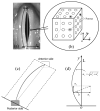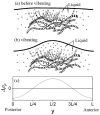Liquid accumulation in vibrating vocal fold tissue: a simplified model based on a fluid-saturated porous solid theory
- PMID: 19660905
- PMCID: PMC3174496
- DOI: 10.1016/j.jvoice.2008.09.005
Liquid accumulation in vibrating vocal fold tissue: a simplified model based on a fluid-saturated porous solid theory
Abstract
The human vocal fold is treated as a continuous, transversally isotropic, porous solid saturated with liquid. A set of mathematical equations, based on the theory of fluid-saturated porous solids, is developed to formulate the vibration of the vocal fold tissue. As the fluid-saturated porous tissue model degenerates to the continuous elastic tissue model when the relative movement of liquid in the porous tissue is ignored, it can be considered a more general description of vocal fold tissue than the continuous, elastic model. Using the fluid-saturated porous tissue model, the vibration of a bunch of one-dimensional fibers in the vocal fold is analytically solved based on the small-amplitude assumption. It is found that the vibration of the tissue will lead to the accumulation of excess liquid in the midmembranous vocal fold. The degree of liquid accumulation is positively proportional to the vibratory amplitude and frequency. The correspondence between the liquid distribution predicted by the porous tissue theory and the location of vocal nodules observed in clinical practice, provides theoretical evidence for the liquid accumulation hypothesis of vocal nodule formation (Jiang, Ph.D., dissertation, 1991, University of Iowa).
(c) 2010 The Voice Foundation. Published by Mosby, Inc. All rights reserved.
Figures





Similar articles
-
A fluid-saturated poroelastic model of the vocal folds with hydrated tissue.J Biomech. 2009 Apr 16;42(6):774-80. doi: 10.1016/j.jbiomech.2008.12.006. Epub 2009 Mar 5. J Biomech. 2009. PMID: 19268294 Free PMC article.
-
Characterizing liquid redistribution in a biphasic vibrating vocal fold using finite element analysis.J Voice. 2015 May;29(3):265-72. doi: 10.1016/j.jvoice.2014.08.010. Epub 2015 Jan 22. J Voice. 2015. PMID: 25619469 Free PMC article.
-
Effects of poroelastic coefficients on normal vibration modes in vocal-fold tissues.J Acoust Soc Am. 2011 Feb;129(2):934-43. doi: 10.1121/1.3533692. J Acoust Soc Am. 2011. PMID: 21361450
-
Synthetic, self-oscillating vocal fold models for voice production researcha).J Acoust Soc Am. 2024 Aug 1;156(2):1283-1308. doi: 10.1121/10.0028267. J Acoust Soc Am. 2024. PMID: 39172710 Free PMC article. Review.
-
Vocal fold dynamics for frequency change.J Voice. 2014 Jul;28(4):395-405. doi: 10.1016/j.jvoice.2013.12.005. Epub 2014 Apr 13. J Voice. 2014. PMID: 24726331 Review.
Cited by
-
Study of spatiotemporal liquid dynamics in a vibrating vocal fold by using a self-oscillating poroelastic model.J Acoust Soc Am. 2020 Oct;148(4):2161. doi: 10.1121/10.0002163. J Acoust Soc Am. 2020. PMID: 33138511 Free PMC article.
-
A fluid-saturated poroelastic model of the vocal folds with hydrated tissue.J Biomech. 2009 Apr 16;42(6):774-80. doi: 10.1016/j.jbiomech.2008.12.006. Epub 2009 Mar 5. J Biomech. 2009. PMID: 19268294 Free PMC article.
-
Characterizing liquid redistribution in a biphasic vibrating vocal fold using finite element analysis.J Voice. 2015 May;29(3):265-72. doi: 10.1016/j.jvoice.2014.08.010. Epub 2015 Jan 22. J Voice. 2015. PMID: 25619469 Free PMC article.
-
Toward Development of a Vocal Fold Contact Pressure Probe: Bench-Top Validation of a Dual-Sensor Probe Using Excised Human Larynx Models.Appl Sci (Basel). 2019 Oct 2;9(20):4360. doi: 10.3390/app9204360. Epub 2019 Oct 16. Appl Sci (Basel). 2019. PMID: 34084559 Free PMC article.
-
Biophysical aspects of mechanotransduction in cells and their physiological/biological implications in vocal fold vibration: a narrative review.Front Cell Dev Biol. 2025 Jan 27;13:1501341. doi: 10.3389/fcell.2025.1501341. eCollection 2025. Front Cell Dev Biol. 2025. PMID: 39931244 Free PMC article. Review.
References
-
- Hirano M, Matsuo K, Kakita Y, Kawasaki H, Kurita S. Vibratory behavior versus the structure of the vocal fold. In: Titze IR, Scherer RC, editors. Vocal Fold Physiology: Biomechanics, Acoustics and Phonatory Control. The Denver Center for the performing Arts; 1983. pp. 26–40.
-
- Titze IR, Strong WJ. Normal modes in vocal cord tissues. J Acoust Soc Am. 1975;57:736–744. - PubMed
-
- Titze IR. On the mechanics of vocal-fold vibration. J Acoust Soc Am. 1976;60:1366–1380. - PubMed
-
- Stemple JC, Glaze LE, Klaben BG. Clinical Voice pathology: Theory and Management. 3rd. Singular Thomson Learning; San Diego: 2000.
-
- Titze IR. The physics of small-amplitude oscillation of the vocal folds. J Acoust Soc Am. 1988;83:1536–1552. - PubMed
Publication types
MeSH terms
Grants and funding
LinkOut - more resources
Full Text Sources
Research Materials

